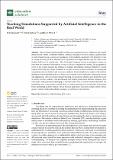Teaching Simulations Supported by Artificial Intelligence in the Real World
Author(s)
Chaturvedi, Iti; Cambria, Erik; Welsch, Roy E.
Downloadeducation-13-00187.pdf (771.6Kb)
Publisher with Creative Commons License
Publisher with Creative Commons License
Creative Commons Attribution
Terms of use
Metadata
Show full item recordAbstract
Video conferencing has enabled synchronous communication in a classroom and created multi-sensory content to stimulate learners. Artificial intelligence involves complex equations that are better taught using a constructive pedagogy where students experiment with alternative ways of solving the same problem. Multiple-choice questions have high reliability and can easily reveal student skill levels in a quick way. The Australian Computer Society accreditation exercise ensures that the content for each subject serves as a flexible template for teaching. The geographical extent of the country requires the presence of multiple subordinate campuses affiliated to a main campus. Following the concept of strands, it was also necessary to show continuity in learning and assessments between the first- and second-year subjects. Student feedback for subjects with artificial intelligence-based simulations showed that several students found it difficult to understand lectures and assignments. Hence, to measure student learning, we introduced a Kahoot quiz during the recess of each lecture that students could join through their mobile phones from different campuses. Software project management is challenging for students with vision or attention-related disorders. We taught them how to use charts to visually observe variables and narrow down possible relationships before performing in-depth analysis. One of the main purposes of education is employability. Hence, greater context to real world industry examples was introduced into lectures.
Date issued
2023-02-10Department
Sloan School of ManagementPublisher
Multidisciplinary Digital Publishing Institute
Citation
Education Sciences 13 (2): 187 (2023)
Version: Final published version